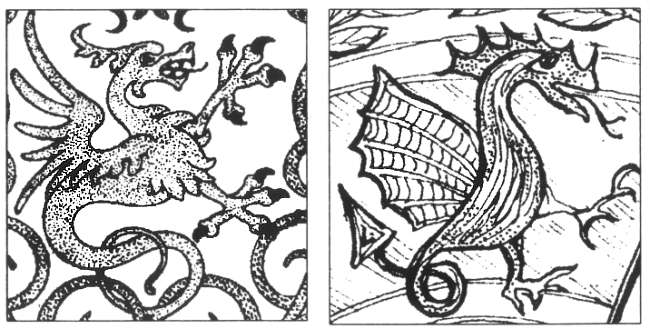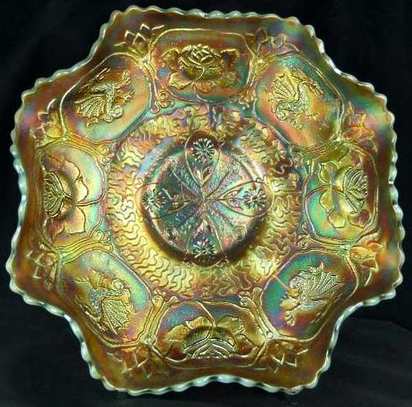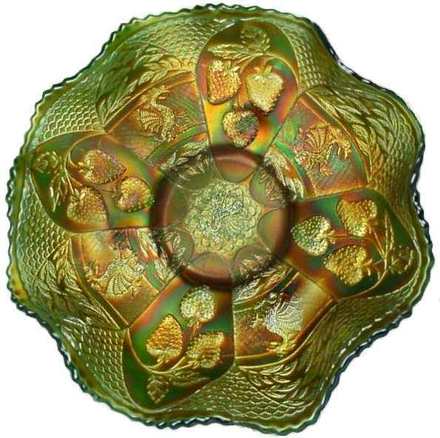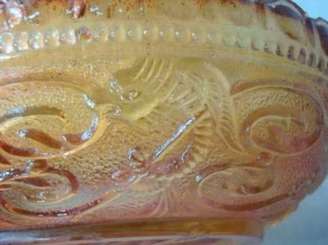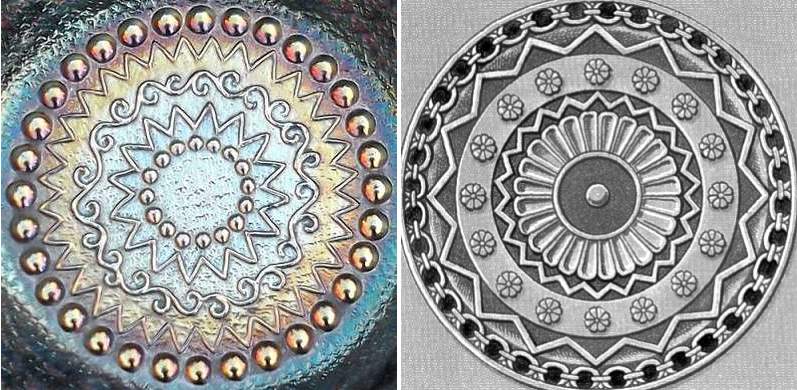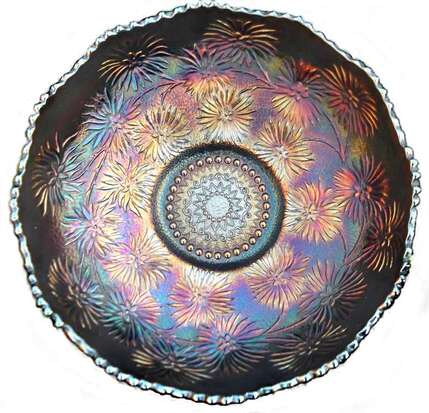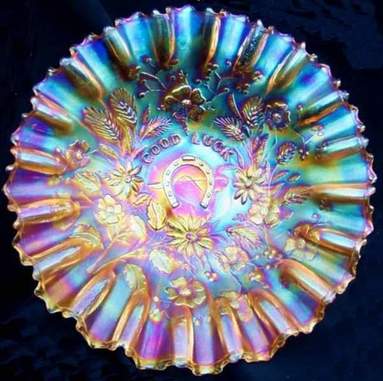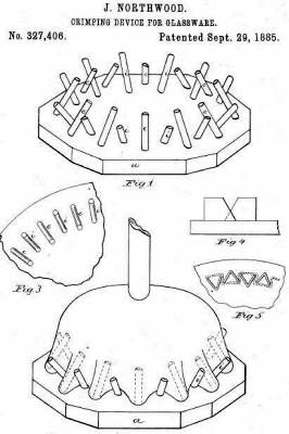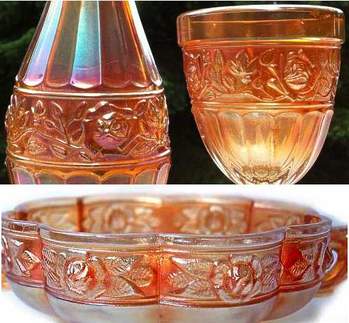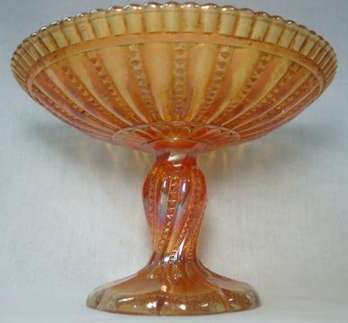NetworK ezine Issue 21. February 2017
by Glen and Stephen Thistlewood
Totally Devoted to Carnival Glass
Totally Devoted to Carnival Glass
|
Here Be Dragons!
Welcome to the Chinese New Year of The Rooster! The dragon dance is a traditional Chinese New Year celebration; dragons are believed to have great power, dignity and wisdom, and they will bring good luck. Dragons are legendary - fiction and film fodder, made “real” by today’s computer generated wizadry. The idea of them has captivated and mystified us for centuries. The number of toes dragons possess is interesting: three in Japan, while British Tudor dragons and regular Chinese dragons have four, but top-of-the-range Chinese Emperor dragons have five! Doubtless, Fenton felt that featuring a dragon on their Carnival Glass would bring an "oriental" feel to the design. They certainly appealed to the public and sold well. Fenton used a four-toed dragon design on their Dragon and Lotus pattern (shown far right), which is quite similar to the 1894 design that was shown in the "Studio" magazine (immediate right). A similar dragon design was used on their less frequently seen - and bizarrely partnered - Dragon and Strawberry patterns. There are two curious five-toed aberrations on spatula footed examples of Dragon and Lotus. |
Above: the 1894 prize-winning drawing that featured
in the well-known “Studio” magazine (left). On the right is Fenton's design on their Dragon and Lotus pattern. |
Fenton’s Dragon and Lotus (below, left) was a hugely popular design, and it’s known in a very wide range of colours. Bowls (spatula-footed and collar based) are plentiful while plates are very hard-to-find. The bowl shown here is aqua opal, a scarcer colour.
On the other hand, the larger and impressive Dragon and Strawberry (below right, in green), is not easy to find and is known in a much smaller range of
Did you know that there is also a dragon on items made in Brazil?
|
Let’s finish this look at dragons by going to South America now … to Brazil.
Over a number of years, we have collaborated closely with Claudio Deveikis (a South American glass researcher and writer) and we are progressively uncovering and publishing so much new information about Carnival Glass made in South America. There are many unique and very pretty patterns and shapes as well as some that look sort of "familiar but somehow different". Claudio's most recent, astonishing discovery is this amazing Dragon bowl (right). His research shows that the design is a copy of an earlier Portieux pattern. but this beautiful Carnival version, however, is signed ESBERARD RIO, moulded in the glass. Esberard was a Brazilian glass maker, and you can read much about them and their surprising range of Carnival patterns on our website (courtesy of Claudio). We also recommend you visit Claudio’s Blog to see more. The links are at the foot of this NetworK ezine. |
Dragon bowl, Esberard. Courtesy Claudio Deveikis
|
Little Daisies
Fenton’s Little Daisies is a seldom seen pattern, and in this blue, ice cream shape (round and un-ruffled) it is rare indeed. Our sincere thanks to Lynne Martin, who recently found this treasure in the UK, for sharing it with us here in NetworK.
It’s fascinating to study this unusual – and beautiful – design.
|
What inspired it, do you think? When Carnival patterns were being created, it’s almost certain that the designers looked at “Style Books”. They were very popular sources of fashionable and "in vogue" designs and creative ideas, like Oriental motifs and specific themes such as peacocks and feathers. The main part of the Little Daisies pattern is clearly intended to be floral (although there’s no doubt that it also looks like scintillating fireworks in the night sky) but stop a moment and look at the central design. As we browsed some of the Style Books (Owen Jones “Grammar of Ornament” is one that was used a lot back then) we saw many of these circular designs. It seems very likely that it was something like this that the Fenton designer was inspired by. Above left: the central motif on the Little Daisies bowl, photo courtesy Lynne Martin, and on the right is a Persian design, one of many featured in the “Grammar of Ornament” by Owen Jones.
|
Anyone for Pie?
As Homer Simpson might say ... "Mmmmmm, PIE". Everyone likes a slice of pie, especially home-baked and lovingly crafted by Mom, with the finishing touch of a finger-pinched edge. Carnival collectors, though, might have a different thought in mind when pie crust edge is mentioned - Northwood's magnificent bowl edge treatment, as seen on the marigold Good Luck bowl below.
|
Northwood's pie crust edge (PCE) crimp is a signature characteristic of that factory. No other Carnival maker produced this exact and distinctive edge treatment- it is evidence in itself that Northwood made the piece. |
Members of our NetworK Facebook group will have seen the amazing announcement by Chase Marquis several weeks ago (January 21st) of his find of an ice green Poppy Show bowl with a pie crust edge. The revelation had a rapturous reception on our Facebook page! "Dumbfounded" ... "Never seen this before" ... "Great find" ... "Stunned, just blown away" ... "Thanks for sharing this amazing piece" ... "Amazing, this is the first time I've seen a PCE Poppy Show piece". And of course, if this PCE Poppy Show bowl had turned up decades ago, it would have dispelled the doubts over the actual maker of Poppy Show and Rose Show - the characteristic edge treatment being evidence in itself.
The Northwood family had a history of invention and creativity regarding glass production and shaping. Harry's father, John Northwood I, patented a "Crimping Device" in 1885 - the drawing for his patent is shown above. The bowl being crimped was attached to a punty rod and whilst it was still hot and malleable, it was pushed down onto the crimper (as shown in the bottom part of the sketch). Apparatus like this would have been used to make Northwood’s pie crust edges (using a snap tool, not a punty to hold the bowl by the marie) - it gave glassmakers a quicker and much better way of shaping edges, and the device was adaptable and re-configured to create different crimps.
The Northwood family had a history of invention and creativity regarding glass production and shaping. Harry's father, John Northwood I, patented a "Crimping Device" in 1885 - the drawing for his patent is shown above. The bowl being crimped was attached to a punty rod and whilst it was still hot and malleable, it was pushed down onto the crimper (as shown in the bottom part of the sketch). Apparatus like this would have been used to make Northwood’s pie crust edges (using a snap tool, not a punty to hold the bowl by the marie) - it gave glassmakers a quicker and much better way of shaping edges, and the device was adaptable and re-configured to create different crimps.
|
A Conundrum of Roses A pattern band of beautiful roses on glowing marigold. More than one glass maker produced their own interpretation of this on Carnival Glass, from the early 1900s through to the 1950s! Some of these are exceptionally scarce, while others are easy to find. How to tell which is which? Our feature article "Roses For You" on our website gives you all the info you'll need to identify these similar patterns from four different makers around the world. Right, top image: the rose pattern band on a Band of Roses decanter and goblet, courtesy of Michael O'Brien. Lower image: the rose pattern band on an Aztec Rose candy dish. Click on the image or click here - Roses for You - to read about who made these, and other similar "rose band" style pieces. |
|
Chumbinho!
We’ll close this issue with another fascinating item that was made in Brazil by Esberard (and marked with their name). It’s shown on the right - a beautiful marigold comport, owned by Claudio Deveikis. We were enchanted by its (moulded) twisting stem. You can read more all about it on Claudio’s excellent blog website. Links! Carnival Glass made in South America: explore this wonderful, and developing, world of discoveries. Here is our Collectors Facts page on Esberard's Dragon bowl, and here is our South America Homepage where you can access all the information we have on these newly found patterns, shapes and makers. We guarantee they will surprise you! Blog: Claudio Deveikis also publishes a blog on his website - it has some truly fascinating information. |
We invite you and your friends to join us all on NetworK's fast growing and very active Facebook Group - Carnival Glass NetworK. If you have missed any of the 26 issues of NetworK and NetworK Specials, they are on our Back Issues page.

